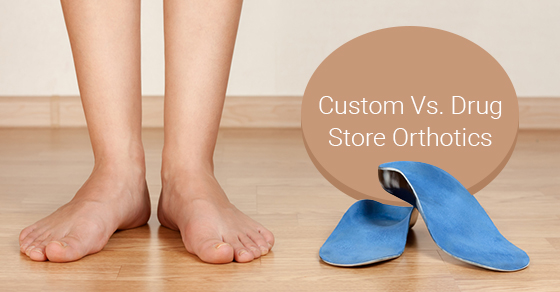Osteoarthritis Treatments: What You Need to Know...
Key Highlights: Osteoarthritis treatments focus on pain relief, restoring joint…
Read More
Posted by Dr. Scott Wilson | 07-Nov-2016
Orthotics are effective tools for people who experience pain. They provide the support needed to keep the foot and ankle joints in proper alignment and reduce stress on the muscles and connective tissues.
However, there are different types of orthotics that you need to know about before deciding which are right for you. Knowing the difference between doctor prescribed and drug store orthotics is the first step to achieving pain relief and improved performance.
Drug store orthotics
Drug store orthotics offer an inexpensive and quick solution for today’s consumers. They’re easily inserted into shoes and can be cut to match any size. Drug store orthotics are typically made from rubber, cork, or silicone and provide varying levels of arch support. These products are widely available and easy to replace – but they may not be ideal for people who have issues related to symmetry in the feet or legs. This makes it difficult to make specific adjustments that provide the relief you’re looking for.
Biomechanical issues and muscle imbalances may require a more customized approach when choosing orthotics.
Doctor prescribed orthotics
Doctor prescribed orthotics offer a solution that’s tailored to your specific needs. They are constructed to ensure each patient receives individualized treatment that helps them to achieve their desired results.
Customized orthotics are designed through the use of foot imaging technology that determines how your orthotics can be designed to create balance and improved biomechanics in the feet and ankles. Doctor prescribed orthotics are constructed in an orthotic laboratory and can be customized to a variety of shoe types. These include athletic and dress shoes, high heels, flats and boots.
Doctor prescribed orthotics offer an individualized approach that leads to better results. This allows for higher efficiency in the movement of your joints. These corrections can support the alignment of the hips and spine, which reduces knee, hip and back pain.
Customized orthotics are designed according to your activity level. Achieving proper movement in sports is essential to preventing injury and eliminating chronic pain issues.
Common problems that can be addressed through doctor prescribed orthotics include plantar fasciitis, heel spurs, Achilles tendonitis, Morton’s neuroma and excessive pronation of the feet.
Choosing the right orthotics for you
Structural and biomechanical dysfunctions can be treated through the use of high-quality, customized orthotics. Although these may require more time to design and construct, they offer lasting relief and are made to meet your unique needs.
A physiotherapist can help you determine the best orthotics for you. They assess foot and ankle stability, arch height and foot width among many other aspects that will determine the orthotics that you’ll need.
Knowing the difference between doctor prescribed and drug store orthotics is essential to achieving relief from pain and recovery from injury.

Key Highlights: Osteoarthritis treatments focus on pain relief, restoring joint…
Read More
Key Highlights: Runner's knee, or patellofemoral pain syndrome, is a…
Read More
Key Highlights: Upper back and neck pain can be caused…
Read More
Key Highlights: Many people want to lose belly fat for…
Read More
Key Highlights: Vestibular physical therapy, or physiotherapy, is a specialized…
Read More
Key Highlights: Tennis elbow, or lateral epicondylitis, is a condition…
Read More